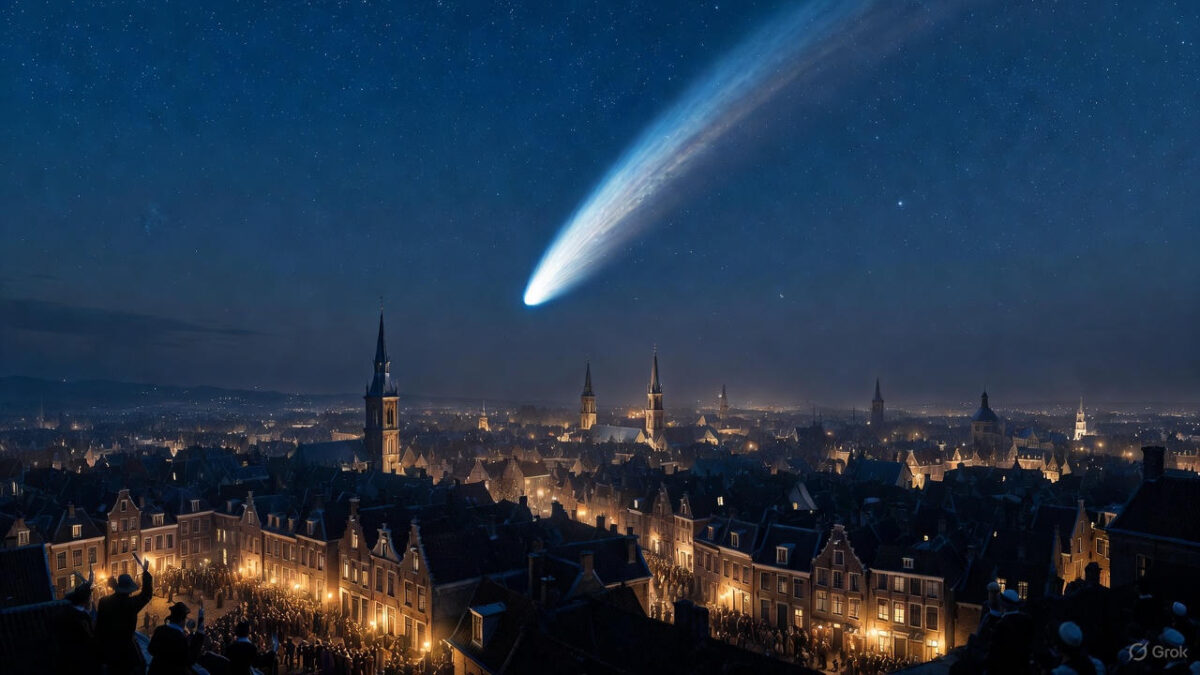On a chilly autumn evening in 1680, as the world teetered on the edge of scientific enlightenment, a German astronomer named Gottfried Kirch peered through his rudimentary telescope and spotted something extraordinary—a blazing streak across the sky that would forever change our understanding of the cosmos. This wasn’t just any celestial wanderer; it was the Great Comet of 1680, the first comet ever discovered using a telescope. Today, on November 14, we revisit this pivotal moment in distant history, delving deep into its details, the era’s astronomical fervor, and the ripple effects that echoed through science. But beyond the facts, we’ll explore how this discovery can inspire you to embrace curiosity in your daily life, turning stargazing into a tool for personal growth and wonder. Buckle up for a journey through time that’s as educational as it is exhilarating!
To set the stage, let’s transport ourselves back to the late 17th century. Europe was emerging from the shadows of the Renaissance, with the Scientific Revolution in full swing. Thinkers like Galileo Galilei had already shaken the foundations of Aristotelian cosmology decades earlier by championing heliocentrism—the idea that the Earth orbited the Sun, not vice versa. By 1680, telescopes, invented around 1608 by Hans Lippershey and popularized by Galileo, had become essential tools for astronomers. These early instruments were far from the high-tech marvels we know today; they were long, cumbersome tubes with lenses that often distorted images due to chromatic aberration. Yet, they opened windows to the universe that humanity had never imagined.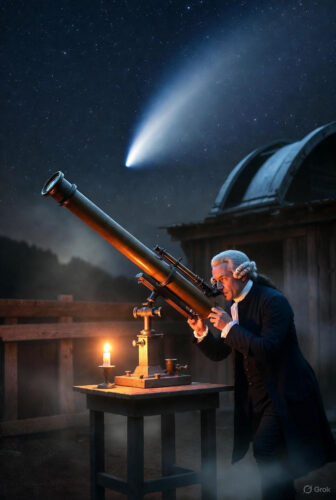
Gottfried Kirch, born in 1639 in Guben, Brandenburg (now part of Germany), was no aristocratic scholar but a self-taught enthusiast. He came from humble beginnings, working as a calendar maker and engraver to support his passion for the stars. Calendar making in that era wasn’t mere date-tracking; it involved astrological predictions and astronomical calculations, blending science with the mysticism that still lingered in society. Kirch’s early life was marked by the Thirty Years’ War’s aftermath, a devastating conflict that ravaged Central Europe from 1618 to 1648, leaving economies in ruins and populations decimated. Amid this chaos, Kirch honed his skills, eventually moving to Leipzig and then to Coburg, where he established a small observatory.
The night of November 14, 1680, was unremarkable at first. Kirch, then 41 years old, was at his observatory in Coburg, systematically scanning the skies as part of his routine observations. Using a telescope with a focal length of about 6 feet—a standard for the time—he was searching for variable stars or other anomalies. Suddenly, in the constellation of Leo, he noticed a fuzzy object with a distinct tail. At first, he might have mistaken it for a nebula or a fixed star, but its motion against the background stars confirmed it was a comet. Comets, derived from the Greek word “kometes” meaning “long-haired,” had long been viewed as omens of doom—harbingers of wars, plagues, or royal deaths. But Kirch, influenced by the emerging rationalism, approached it scientifically.
What made this discovery groundbreaking? Prior to Kirch, comets were observed with the naked eye, like the famous Halley’s Comet sightings dating back to ancient times. Kirch’s use of a telescope allowed for more precise tracking and measurement, marking a shift from qualitative descriptions to quantitative data. He immediately recorded the comet’s position, brightness, and tail length, noting its magnitude as comparable to Jupiter. Over the following days, as the comet brightened, Kirch shared his findings with colleagues via letters—a common communication method in the pre-journal era.
The Great Comet of 1680, also known as C/1680 V1 or Kirch’s Comet, was no ordinary visitor. Orbital calculations later revealed it followed a parabolic path, approaching the Sun to within 0.0062 AU (astronomical units, or about 930,000 kilometers)—closer than any known comet at the time. This perihelion passage on December 18, 1680, made it extraordinarily bright, visible even in daylight for a brief period. Its tail stretched an astonishing 90 degrees across the sky, equivalent to 180 full moons lined up. Observers across Europe, from England to Italy, reported seeing it, and it sparked widespread fascination and fear.
Let’s dive deeper into the comet’s trajectory and characteristics. After Kirch’s initial sighting, the comet moved rapidly toward the Sun, becoming a morning object by late November. From December 4 to March 1681, it reappeared in the evening sky after perihelion, its tail pointing away from the Sun due to solar wind pressure—a phenomenon not understood until the 20th century. The comet’s nucleus was estimated to be several kilometers in diameter, composed of ice, dust, and rock, sublimating as it neared the Sun to form the coma and tail. Historical accounts describe the tail as bifurcated, with a bright dust tail and a fainter ion tail, though observers lacked the terminology we use today.
The cultural impact was immense. In an age where superstition reigned, the comet was interpreted as a divine sign. In England, it coincided with the Exclusion Crisis, fueling political paranoia. In France, Louis XIV’s court buzzed with astrological predictions. Pamphlets and broadsheets proliferated, with titles like “A Dreadful Judgment of God” portraying the comet as a warning. Yet, amid the hysteria, scientists saw opportunity. Johann Hevelius in Danzig (now Gdansk) observed it independently, confirming Kirch’s find. Edmond Halley, then a young astronomer, tracked it from London, later using data from this and other comets to predict periodicity in his 1705 work “Synopsis of the Astronomy of Comets.”
Kirch himself became a celebrity of sorts. His discovery earned him a position as the first official astronomer at the Berlin Observatory, founded in 1700 by the Prussian Academy of Sciences. There, he continued his work, discovering variable stars and collaborating with his wife, Maria Margarethe Kirch, who was an accomplished astronomer in her own right. Maria assisted in the 1680 observations and later discovered her own comet in 1702, becoming one of the first recognized female astronomers. The couple’s partnership highlights the often-overlooked role of women in early science; Maria’s contributions were vital, from calculations to nighttime vigils.
The comet’s scientific legacy is profound. Isaac Newton, in his magnum opus “Principia Mathematica” (1687), used observations of the Great Comet to validate his law of universal gravitation. Newton argued that comets obeyed the same inverse-square law as planets, orbiting in ellipses (or parabolas for hyperbolic ones). Before Newton, comets were thought to travel in straight lines or be atmospheric phenomena, as Aristotle posited. The comet’s close solar approach allowed Newton to calculate gravitational forces accurately, demonstrating that the Sun’s pull extended far beyond planetary orbits.
Expanding on Newton’s involvement: In 1680-81, Newton was at Cambridge, refining his ideas on motion and gravity. He observed the comet personally, noting its pre- and post-perihelion paths. In “Principia,” Book III, Proposition 41, he discusses how the comet’s trajectory curved due to solar gravity, providing empirical evidence against Cartesian vortex theories. This integration of cometary data into gravitational theory was revolutionary, bridging celestial mechanics with terrestrial physics.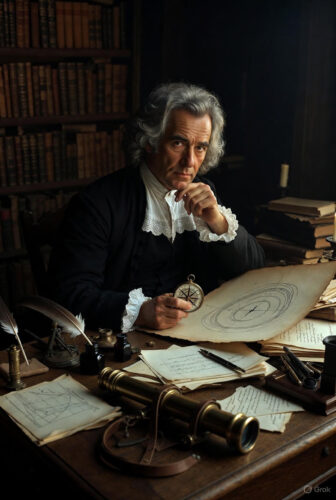
Beyond Newton, the comet influenced orbital mechanics. Johannes Kepler’s laws, formulated earlier in the century, were tested against cometary paths. The Great Comet’s near-parabolic orbit suggested it came from the distant Oort Cloud, a concept formalized in the 20th century but hinted at by 17th-century astronomers. Its brightness also spurred improvements in telescope design; Christiaan Huygens and others experimented with longer focal lengths to reduce aberrations.
Socially, the comet bridged science and public discourse. Newspapers, a nascent medium, reported sightings, democratizing astronomy. In Germany, Kirch published his findings in “Ephemerides,” annual almanacs that combined predictions with observations. This dissemination helped shift comets from omens to natural objects, paving the way for Enlightenment rationalism.
Now, let’s explore the broader astronomical context of 1680. The year was rich in discoveries: Saturn’s rings were better resolved, and Uranus was misidentified as a star. But the comet stood out for its visibility and duration—observable for over four months. Compared to other great comets, like the one of 1577 observed by Tycho Brahe, the 1680 comet was brighter and closer, offering unprecedented data.
Historical records from Asia add global perspective. Chinese astronomers, with millennia of comet observations, noted it in the “Qing Shi Gao” chronicles, describing it as a “broom star” portending change. Jesuit missionaries in China, like Ferdinand Verbiest, corresponded with European colleagues, exchanging data that enriched Western knowledge.
The comet’s physical properties fascinate modern scientists. Spectroscopic analysis (impossible in 1680) would reveal water ice, carbon dioxide, and organics—building blocks of life. Its close solar pass likely caused fragmentation, though it survived. Today, using Kepler’s laws and Newton’s equations, we can retroactively plot its orbit with precision: eccentricity near 1, inclination 60 degrees, period potentially millions of years if bound.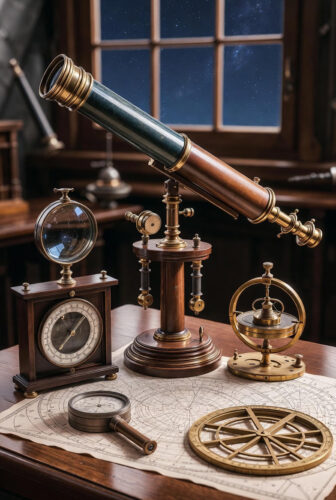
Diving into Kirch’s methodology: He used a micrometer attached to his telescope for angular measurements, a technique pioneered by Hevelius. His notes detail the comet’s daily positions relative to stars like Regulus in Leo. By December, as it approached the Sun, its head brightened to magnitude -2, rivaling Venus. Post-perihelion, the tail extended 70 million kilometers, visible from both hemispheres.
The event’s significance lies in its timing. The 1680s saw the Royal Society’s rise in London and the Academie des Sciences in Paris, fostering international collaboration. Kirch’s correspondence with figures like Leibniz underscores this network. Leibniz, a polymath, discussed the comet in letters, speculating on its composition.
Culturally, the comet inspired art and literature. Dutch painter Lieve Verschuier captured it over Rotterdam in a famous oil painting, showing townsfolk gazing in wonder. Poets like John Dryden alluded to it in works, symbolizing transience.
Fast-forwarding slightly, the comet’s data aided Halley’s 1758 prediction, proving comets return. This demystified them, reducing fear.
Now, after immersing in these historical depths—over two-thirds of our journey focused on the past—let’s pivot to how this discovery benefits you today. The outcome? A testament to human curiosity’s power, showing that one observation can unlock universal truths. Applying this to your life fosters wonder, resilience, and lifelong learning.
Here are specific ways you benefit:
– **Enhanced Problem-Solving Skills**: Just as Kirch methodically scanned the skies, cultivate systematic observation in daily challenges. For instance, when facing a work dilemma, break it into observable parts, track patterns, and predict outcomes—like plotting a comet’s path.
– **Boosted Mental Health Through Wonder**: Stargazing reduces stress; studies show it induces awe, lowering cortisol. Channel Kirch’s excitement to combat modern burnout.
– **Improved Focus and Patience**: Astronomy demands patience; apply this by setting aside time for deep work, free from distractions.
– **Expanded Knowledge Horizons**: Learning about comets sparks interest in STEM, leading to career shifts or hobbies that enrich life.
– **Stronger Relationships**: Share stargazing with loved ones, building bonds like Kirch and Maria’s partnership.
A practical plan to apply this:
- **Week 1: Educate Yourself** – Read a beginner’s astronomy book or watch documentaries on comets. Dedicate 30 minutes daily.
- **Week 2: Acquire Tools** – Buy or borrow a basic telescope/binoculars. Learn constellations via apps like SkyView.
- **Week 3: Observe Regularly** – Set a routine: 3 nights/week, note what you see in a journal, mimicking Kirch’s logs.
- **Week 4: Share and Reflect** – Join an astronomy club or discuss findings online. Reflect on how curiosity has sparked personal growth.
- **Ongoing: Challenge Yourself** – Track a modern celestial event, like a meteor shower, and apply lessons to non-astronomy goals.
Continuing our historical exploration, let’s examine the comet’s role in debunking myths. Pre-1680, comets were tied to catastrophes—the Black Death, earthquakes. Kirch’s precise data helped shift this narrative, aligning with Baconian empiricism.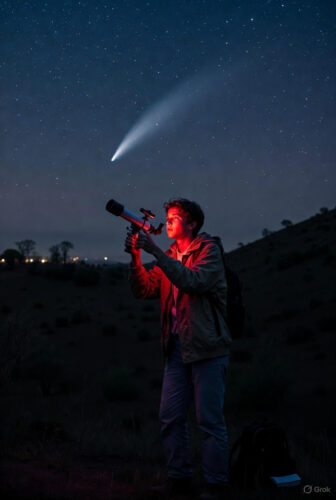
Kirch’s later career flourished; he cataloged stars and published on variable brightness. His death in 1710 left a legacy continued by Maria and their children.
The comet’s orbit, recalculated with modern tools, shows it passed near Earth at 0.42 AU, safe but spectacular.
In popular culture, the comet appears in historical novels and simulations, reminding us of science’s human element.
Wrapping the historical narrative, the Great Comet of 1680 stands as a beacon of discovery, bridging ancient fears and modern understanding. Its story, rich in detail, underscores perseverance’s rewards.
Finally, embracing this legacy today isn’t just about stars—it’s about looking up, questioning, and growing. Let Kirch’s gaze inspire yours!

